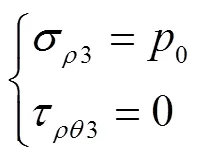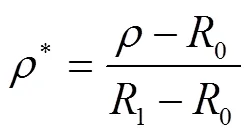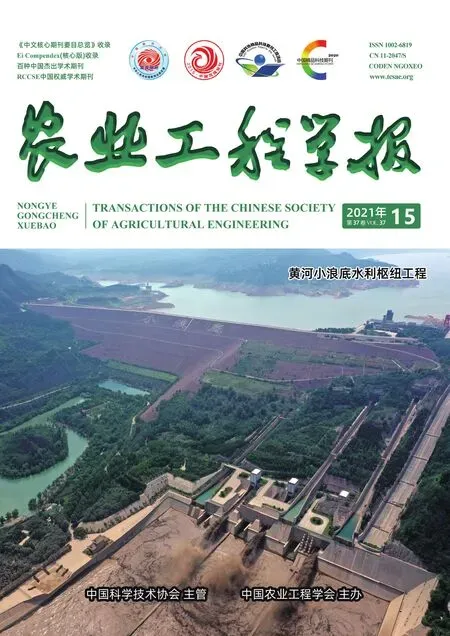非均匀应力场作用下圆形水工隧洞开挖与支护参数设计
2021-11-26吴庆良吴梦军刘冒佚郭鸿雁
吴庆良,吴梦军,方 林,向 荣,刘冒佚,郭鸿雁
非均匀应力场作用下圆形水工隧洞开挖与支护参数设计
吴庆良1,2,3,吴梦军2,3※,方 林2,3,向 荣4,刘冒佚4,郭鸿雁2,3
(1. 西南大学工程技术学院,重庆 400715; 2. 招商局重庆交通科研设计院有限公司,重庆 400067;3. 公路隧道建设技术国家工程实验室,重庆 400067;4. 重庆市城投公租房建设有限公司,重庆 400015)
引水隧洞是农业、水利等工程领域重要的地下结构,确定合理的施工参数是保证隧洞施工安全的前提。该研究基于复变函数方法,考虑开挖卸荷和围岩-衬砌相互作用影响,推导了非均匀应力场下开挖后立即支护时衬砌与围岩光滑接触条件下应力与位移的解析解,并基于最大主应力准则建立隧洞施工参数优化目标函数,以两个不同算例分别设计了隧洞的开挖尺寸和衬砌的弹性模量。研究结果表明:围岩开挖边界引起的应力集中以及衬砌内部的应力分布均与隧洞开挖尺寸、内部水压力、原岩应力场中的水平侧压力系数、围岩与衬砌的物理力学参数等有关;当水平侧压力系数大于1.00时,衬砌内最大主应力值会随着隧洞开挖尺寸的增大而增大,甚至会在衬砌内壁0°和90°处附近出现拉应力;当水平侧压力系数小于1.00时,衬砌内最大主应力值会随着衬砌材料弹性模量的增大而增大。通过分析两个算例可知,合理限制隧洞开挖尺寸、适当增加衬砌内壁处的配筋率均有利于隧洞衬砌安全;采用高强度低弹性模量的混凝土配比用于衬砌,可提高衬砌的承载能力。研究结果可为相关工程中隧洞的开挖与支护参数设计等提供理论借鉴和参考。
隧道衬砌;弹性模型;圆形隧洞;参数设计;应力场;复变函数方法
0 引 言
引水隧洞是广泛应用于农业、水利等工程领域的地下结构[1-3],为了保证其安全使用,常在隧洞内模筑钢筋混凝土衬砌。由于隧洞的开挖扰动改变了原岩应力场,围岩应力重分布过程随着开挖尺寸、支护参数、支护时机等不同而千差万别[4-7],因此,确定合理的施工参数是保证隧洞施工安全的前提[8-9]。
当前,隧洞施工参数的优化设计主要依赖于工程类比为主的经验设计法,再根据预设参数建立模型进行验算[10-11];也有一部分学者基于室内物理模型试验或现场试验段的结果指导隧洞的支护参数或结构的体型参数设计[12-14];随着隧洞埋深越来越大,地质构造越来越复杂,又有不少学者提出采用现场试验、数值计算等多手段相结合的方法进行施工参数优化设计[15-17],如曲星等[16]根据青海省江源水电站引水隧洞现场监测资料反演得出分析洞段围岩参数,以此参数为依据采用有限元软件对比了4种不同支护方案的优劣;Luo等[17]对大跨度隧道支护结构的变形特性和力学特性进行了实测分析,并采用有限元软件对不同支护参数下的支护结构安全性进行了模拟计算获取最优支护参数。
由于现场监测费时费力,数值计算模型因工况不同而不具备可重复性,故基于围岩与衬砌应力场分布的施工参数反演分析方法越来越得到较多学者青睐[18-20],如杨凯等[18]考虑围岩松动圈支护体的影响,推导出深埋圆形隧洞衬砌应力解析解,引入功能梯度材料思想,讨论了不同弹性模量双层混凝土圆形衬砌的优化设计;于远祥等[19]通过建立预应力锚杆与隧洞围岩的相互作用力学模型,并以秦岭某引水隧洞为工程背景,利用所提出的理论公式计算了该隧洞极不稳定区段围岩变形范围及洞壁位移量,进而对原开挖及支护方案进行了优化;Zhou等[20]考虑了锚杆的流变模型,应力释放系数和附加径向力等建立了三种隧道支护条件,推导了初次支撑和二次衬砌上位移的解析公式,并以此得到了不同支护参数下的支护荷载变化。然而这些力学解析模型都是基于均匀的原岩应力场假设,也未考虑隧洞开挖卸荷影响。
基于此,本文基于复变函数幂级数方法,考虑开挖卸荷和围岩-衬砌相互作用影响,推导非均匀应力场下开挖后立即支护时衬砌与围岩光滑接触条件下的应力与位移的解析解,并基于最大主应力准则建立隧洞施工参数优化目标函数,以两个不同算例分别设计隧洞的开挖尺寸和衬砌的弹性模量。以期为相关工程中隧洞的开挖与支护参数设计等提供借鉴与参考。
1 研究方法
1.1 力学模型
根据地下洞室力学分析的复变函数相关理论[22-23]可知


式中σ、σ、σ分别代表径向应力、切向应力和剪应力;u、u分别代表径向位移和切向位移;为复平面变量;κ为中间参数;G为剪切模量。且有
式中、分别为极坐标系下的半径和角度;为自然常数,为虚数;μ、E分别为泊松比和弹性模量。
只要求出相应工况的两个解析函数φ()、ψ(),即可得出隧洞以及衬砌的应力分量和位移分量。
此处需要说明的是,本文求解过程中的物理参数均取国际单位制中的基本单位,如σ、σ、σ、σ、σ、τ、、0、E、G单位均为Pa,0、1、u、u、单位均为m,单位为rad(第四节的算例中为方便书写均换算为°),、κ、μ均无量纲。参数下标=1,2分别表示无支护、有支护状态下的围岩,=3表示衬砌,下标、分别表示径向和切向方向,上标、分别表示围岩和衬砌。
1.2 围岩与衬砌的解析函数
1)隧洞开挖卸荷后无支护时围岩的解析函数
原岩应力场下,隧洞的开挖卸荷作用会造成隧洞边界上“面力解除”,不考虑支护反力作用,利用复变函数方法即可求出隧洞开挖后≥1域内围岩的两个解析函数[24]1()、1()为
将式(5)代入式(3),即可求出围岩内部任意一点的径向位移u和切向位移u为

2)开挖后立即支护时隧洞与围岩的解析函数
假定隧洞开挖后立即进行衬砌支护,且设置支护后围岩与衬砌相互作用,围岩仅在支护作用下对应的两个解析函数2()、2()可用Taylor级数[25-26]表示为
式中为级数的项数。
围岩对衬砌作用后,衬砌内的两个复势函数[25-26]3()和3()可用Laurent级数表示为
式(7)和式(8)中的a、b、c、d、e、f(≥1)均为待定的实数,可由1.3节给出的边界条件确定。
1.3 边界条件与求解过程
根据求解的力学模型可知,衬砌内边界(=0)上的应力边界条件为

围岩与衬砌接触面(=1)上的光滑接触条件[27]为

假定围岩在支护前后的弹性参数未发生改变,即1=2,1=2。将隧洞开挖后支护前、后围岩与衬砌的六个解析函数(式(5)、式(7)和式(8))代入到式(9)和式(10)中,联立式(1)~式(3),并进一步对幂级数整理分析可以发现:当≥2时,系数a、b+2、c、d+2、e+2、f都等于0,不为0的系数只有1、1、3、1、1、3、1、3、1,而这些系数又可由线性方程组(11)~(19)求出






将求解出的参数代入式(7)~式(8)从而得到非均匀应力场下考虑开挖卸荷影响,以及围岩与衬砌相互作用后围岩和衬砌的复势函数。
2 衬砌和围岩中应力与位移分量求解
给定围岩与衬砌的相关参数0、1、、、0、1、1、2、2的具体数值后,联立求解线性方程组(11)~(19),可得出待定的系数1、1、3、1、1、3、1、3、1。待求的围岩解析函数2()、2(),以及衬砌的解析函数3()、3()可写为

显然,衬砌中的应力由式(21)联立式(1)~式(3)求出。


而围岩中的应力不仅需要考虑1.2小节中的两部分,还需要叠加上开挖前的原岩应力场,而原岩应力场解析函数[24]0()和0()为
即原岩应力场作用下,考虑开挖卸荷、衬砌与围岩相互作用,开挖后立即进行支护时围岩应力场的两个最终解析函数φ()和ψ()为

将式(26)和式(27)代入式(1)和式(2)可求得



3 结果与分析
3.1 解析解的验证
假设隧洞开挖后没有施作衬砌,则式(7)中围岩仅在支护作用下对应的两个解析函数不存在,即系数a=b=0,此时式(28)~式(30)可写为


上述结果与经典的Kirsch解完全一致[29],这验证了本文解析解的正确性。
3.2 隧洞施工参数优化目标函数构建
隧洞施工参数优化设计的目的是为了保证衬砌内部受力更合理。根据式(22)~式(24)可知,围岩开挖边界引起的应力集中以及衬砌内部的应力分布均与隧洞开挖尺寸、内部水压力、围岩侧压力系数以及衬砌的弹性模量等有关,在原岩应力场、岩体物理力学性质、过水断面尺寸、内水压力等已定的情况下,可通过改变隧洞开挖尺寸、选择合理的混凝土弹性模量等改变衬砌内部受力。
鉴于此,构造衬砌优化设计的目标函数如下:

约束条件为

式中、为大于0的实常数,两者均根据设计工况而定。本文待优化变量是开挖尺寸1和混凝土弹性模量3。
当衬砌内部有拉应力产生时,补充约束条件为

3.3 算例一:围岩开挖尺寸的设计
针对水平地应力小于垂直地应力的地质环境:假定原岩应力场=10.00 MPa,侧压力系数为=0.40,弹性参数1=0.25,1=5.00 GPa,衬砌拟采用的钢筋混凝土材料折合弹性参数2=0.20,2=20.00 MPa,抗压强度f=25.00 MPa,抗拉强度f=4.00 MPa,衬砌内半径0=3.00 m,内部承受静水压力0的作用,且0≤3.00 MPa,现需确定围岩的开挖尺寸。
根据目标函数式(35),采用Matlab优化工具箱可求解围岩的最大的开挖半径为1=3.67 m。为证明以上分析和求解的正确性,下文对1=3.67 m与1=4.00 m两种开挖半径下的衬砌内部应力分布(分别如图2和图3所示)做对比分析。
由于开挖半径不同造成横坐标轴不一致,为更直观对比两种开挖半径下的应力分布特征,故先对数据进行归一化处理,即对半径进行离差标准化,使横坐标值映射到[0,1]区间。转换函数如下:

式中*为归一化处理后的开挖半径。

从图3可以看出,当开挖半径1=4.00 m时,衬砌内部出现最大主应力大于25.00 MPa的情况,即最大值28.29 MPa出现在=0°时的内壁处(图3a与图3b左上角),超出了衬砌材料的抗压强度极限;而最小主应力也出现了负值,即在衬砌内壁=0°和=90°处附近出现了拉应力(图3a和图3b中的点虚线以下)。从图3a可以看出,径向方向上,拉应力区在=0°处分布在≥3.97 m(≥0.97)范围内,在=90°处分布在≤3.07 m(≤0.07)范围内,从图3b可以看出,环向方向上,拉应力区在衬砌外壁处分布在0°≤≤10.23°范围内,在衬砌内壁处分布在73.86°≤≤90°范围内,且最大值为2.37 MPa。

以上表明,当围岩与衬砌的物理力学参数均已知,水平侧压力系数小于1.00时,隧洞开挖尺寸越大,衬砌内最大主应力值越大,且出现在=0°时的内壁处;隧洞的最大和最小主应力的表达式并不固定,在径向和环向方向上都会产生转换;随着开挖尺寸的进一步扩大,在衬砌内壁=0°和=90°处附近也会出现拉应力,考虑到混凝土的抗拉强度较低,在隧洞支护设计时需更加注意。
3.4 算例二:衬砌材料弹性模量的设计
针对水平地应力大于垂直地应力的地质环境:假定原岩应力场=10.00 MPa,侧压力系数为=1.20,围岩的开挖半径1=4.00 m,弹性参数1=0.25,1=5.00 GPa,衬砌拟采用的钢筋混凝土材料折合弹性参数1=0.20,抗压强度f=25.00 MPa,抗拉强度f=4.00 MPa,衬砌内半径0=3.00 m,内部承受静水压力0的作用,且取0≤3.00 MPa,现需确定衬砌的弹性模量。
根据目标函数式(35),采用Matlab的优化工具箱可求解衬砌材料的最大弹性模量为3=14.71 GPa,此时衬砌内部的最大或最小主应力均不能超过给定的抗压或抗拉强度极限。同样,为证明以上分析和求解的正确性,下面给出3=14.71 GPa与3=15.00 GPa两种弹性模量下衬砌内部应力分布(分别如图4和图5所示)做对比分析。
从图4可以看出,当衬砌弹性模量3=14.71 GPa时,衬砌内部各位置的最大主应力均小于25.00MPa,最大值出现在=90°时的内壁处(图4a左上角与图4b右上角),最大值为24.999 968 MPa,最小主应力为3.00 MPa,在衬砌内壁的环向各处(图4b中的底部虚线),即衬砌内部无拉应力出现,压应力也均满足衬砌材料的抗压强度要求。
从图5可以看出,当弹性模量3=15.00 GPa时,衬砌内部出现最大主应力大于25.00 MPa的情况,即最大值25.26 MPa出现在=90°时的内壁处(图5a左上角与图5b右上角),超出了衬砌材料的抗压强度极限。实际工程中为防止衬砌变形破坏常规做法是提高混凝土的抗压强度,对于传统的混凝土材料来说,提高其强度也会相应提高了其弹性模量,若能设计高强度低弹性模量的混凝土配比用于衬砌,会减少其内部最大主应力峰值,有利于提高衬砌的承载能力。
4 结 论
本文在考虑开挖卸荷和围岩-衬砌相互作用影响下,采用复变函数方法推导了非均匀应力场下开挖且立即支护时衬砌与围岩光滑接触条件下的应力与位移的解析解,并基于最大主应力准则建立隧洞施工参数优化目标函数,通过对不同测压力系数下隧洞的开挖尺寸和衬砌的弹性模量的优化设计,得出了以下结论:
1)围岩开挖边界引起的应力集中以及衬砌内部的应力分布均与隧洞开挖尺寸、内部水压力、原岩应力场中的水平侧压力系数、围岩与衬砌的物理力学参数等有关。
2)在水平侧压力系数大于1.00时,衬砌内最大主应力值会随着隧洞开挖尺寸的增大而增大,因而合理地限制隧洞开挖尺寸有益于减少衬砌支护成本;随着隧洞开挖尺寸的进一步扩大,衬砌内部最大和最小主应力会在径向和环向方向上产生转换,甚至会在衬砌内壁=0°和=90°处附近出现拉应力,支护设计时可适当增加衬砌内壁处的配筋率以增强其抗拉强度。
3)在水平侧压力系数小于1.00时,衬砌内最大主应力值会随着衬砌材料弹性模量的增大而增大。若能设计高强度低弹性模量的混凝土配比用于衬砌,一方面可以提高衬砌本身的抗压强度,另一方面又可以减少其内部最大主应力峰值,对于提高衬砌的承载能力有较好的效果。
[1] 张宽地,吕宏兴,赵延风. 明流条件下圆形隧洞正常水深与临界水深的直接计算[J]. 农业工程学报,2009,25(3):1-5.
Zhang Kuandi, Lyu Hongxing, Zhao Yanfeng. Direct calculation for normal depth and critical depth of circular section tunnelunder free flow[J]. Transactions of the Chinese Society of Agricultural Engineering (Transactions of the CSAE), 2009, 25(3): 1-5. (in Chinese with English abstract)
[2] 贡力,李雅娴,靳春玲. 流冰对引水隧洞撞击破坏力学特性数值分析与验证[J]. 农业工程学报,2018,34(13):144-151.
Gong Li, Li Yaxian, Jin Chunling. Numerical simulation and verification on impact damage mechanical property of drift ice on diversion tunnel[J]. Transactions of the Chinese Society of Agricultural Engineering (Transactions of the CSAE), 2018, 34(13): 144-151. (in Chinese with English abstract)
[3] 雷江,陈卫忠,李翻翻,等. 引红济石引水隧洞围岩力学特性研究[J]. 岩土力学,2019,40(9):3435-3446.
Lei Jiang, Chen Weizhong, Li Fanfan, et al. Mechanical properties of surrounding rock in diversion tunnel of water diversion project from Hongyan River to Shitou River[J]. Rock and Soil Mechanics, 2019, 40(9): 3435-3446. (in Chinese with English abstract)
[4] 周春华,尹健民,丁秀丽,等. 秦岭深埋引水隧洞地应力综合测量及区域应力场分布规律研究[J]. 岩石力学与工程学报,2012,31(S1):2956-2964.
Zhou Chunhua, Yin Jianmin, Ding Xiuli, et al. Complex measurements of geo-stress in deep diversion tunnel and research on distribution law of regional stress field in Qinling mountain[J]. Chinese Journal of Rock Mechanics and Engineering, 2012, 31(S1): 2956-2964. (in Chinese with English abstract)
[5] 朱泽奇,盛谦,周永强,等. 隧洞围岩应力开挖扰动特征与规律研究[J]. 应用基础与工程科学学报,2015,23(2):349-358.
Zhu Zeqi, Sheng Qian, Zhou Yongqiang, et al. Stress disturbance characteristics and law research of surrounding rock during tunnel excavation[J]. Journal of Basic Science and Engineering, 2015, 23(2): 349-358. (in Chinese with English abstract)
[6] 周辉,高阳,张传庆,等. 考虑围岩衬砌相互作用的钢筋混凝土衬砌数值模拟[J]. 水利学报,2016,47(6):763-771.
Zhou Hui, Gao Yang, Zhang Chuanqing, et al. Numerical simulation of reinforced concrete lining considering the interaction with the surrounding rock[J]. Journal of Hydraulic Engineering, 2016, 47(6): 763-771. (in Chinese with English abstract)
[7] Xu D P, Huang X, Jiang Q, et al. Estimation of the three-dimensional in situ stress field around a large deep underground cavern group near a valley[J]. Journal of Rock Mechanics and Geotechnical Engineering, 2021, 13(3): 529-544.
[8] Özsan A, Başarır H. Support capacity estimation of a diversion tunnel in weak rock[J]. Engineering Geology, 2003, 68(3): 319-331.
[9] 刘宁,房敦敏,张传庆. 深埋引水隧洞复合承载结构运行期安全性评价[J]. 科技通报,2015,31(1):103-107.
Liu Ning, Fang Dunmin, Zhang Chuanqing. Safety assessment of deep buried diversion tunnel composite bearing structure runtime[J]. Bulletin of Science and Technology, 2015, 31(1): 103-107. (in Chinese with English abstract)
[10] 孙星亮,李宏建,朱永全. 大断面水工隧洞方案优化设计[J]. 石家庄铁道学院学报,2005(3):5-8.
Sun Xingliang, Li Hongjian, Zhu Yongquan. Scheme optimization design of large section hydraulic tunnel[J]. Journal of Shijiazhuang Railway University, 2005(3): 5-8. (in Chinese with English abstract)
[11] 李俊美. 新疆地区典型引水隧洞围岩力学特性及稳定性分析[D]. 重庆:重庆大学,2017.
Li Junmei. Study on Mechanical Properties and Stability Analyses of Surrounding Rocks of Typical Diversion Tunnel in Xinjiang Area[D]. Chongqing: Chongqing University, 2017. (in Chinese with English abstract)
[12] 丁鹏宇,马旭东,李强,等. 导流隧洞出口小挑坎体型参数试验研究[J]. 中国农村水利水电,2019(4):96-98.
Ding Pengyu, Ma Xudong, Li Qiang, et al. Experimental research on the shape parameters of small flip bucket at diversion tunnel outlet[J]. China Rural Water and hydropower, 2019(4): 96-98. (in Chinese with English abstract)
[13] 唐贵强. 秦岭隧洞岩爆应力解除爆破及支护参数优化[J]. 人民黄河,2019,41(2):130-134.
Tang Guiqiang. Study on rock burst stress relieving blasting and supporting parameter optimization of Qinling Tunnel[J]. Yellow River, 2019, 41(2): 130-134. (in Chinese with English abstract)
[14] Sun M L, Zhu Y Q, Li X Z, et al. Experimental Study of Mechanical Characteristics of Tunnel Support System in Hard Cataclastic Rock with High Geostress[J]. Shock and Vibration, 2020, 2020(5): 1-12.
[15] Basarir H, Ozsan A, Karakus M. Analysis of support requirements for a shallow diversion tunnel at Guledar dam site, Turkey[J]. Engineering Geology, 2005, 81(2): 131-145.
[16] 曲星,李宁,张志强. 围岩力学参数对水工隧洞运行期衬砌受力影响分析及工程应用[J]. 西安理工大学学报,2012,28(4):404-410.
Qu Xing, Li Ning, Zhang Zhiqiang. Analysis of the influence of surrounding rock mechanics parameters on lining stress during operation of hydraulic tunnel and its engineering application[J]. Journal of Xi'an University of Technology, 2012, 28(4): 404-410. (in Chinese with English abstract)
[17] Luo Y B, Chen J X, Shi Z, et al. Mechanical and deformation characteristics and optimization of support parameters for superlarge-span tunnel: A case study from laohushan Tunnel[J]. Advances in Civil Engineering, 2020, 2020(1): 1-17.
[18] 杨凯,吴顺川,吴庆良,等. 考虑围岩松动圈支护体影响的深埋圆形隧道衬砌优化设计[J]. 工程科学学报,2015,37(7):839-843.
Yang Kai, Wu Shunchuan, Wu Qingliang, et al. Optimization design of deep circular tunnel lining considering the influence of surrounding rock loose circle support[J]. Journal of Engineering Science, 2015, 37(7): 839-843. (in Chinese with English abstract)
[19] 于远祥,姚尧,王京滨,等. 杆岩耦合作用下深埋隧洞围岩稳定性主控因素及支护优化研究[J]. 现代隧道技术,2021,58(1):19-26.
Yu Yuanxiang, Yao Yao, Wang Jingbin, et al. Study on main control factors of surrounding rock stability and support optimization of deep tunnel under the coupling action of rod and rock[J]. Modern Tunnel Technology, 2021, 58(1): 19-26. (in Chinese with English abstract)
[20] Zhou J, Yang X A, Ma M J, et al. The support load analysis of deep-buried composite lining tunnel in rheological rock mass[J]. Computers and Geotechnics, 2021, 130: 103934.
[21] 蔡美峰. 岩石力学与工程[M]. 第2版. 北京:科学出版社,2013:296-313.
[22] Muskhelishvili N I. Some Basic Problems of the Mathematical Theory of Elasticity[M]. Groningen: Noordhoff International Publishing, 1977: 105-166.
[23] 陈子荫. 围岩力学分析中的解析方法[M]. 北京:煤炭工业出版社,1994.
[24] Lyu A Z, Zhang L Q, Zhang N. Analytic stress solutions for acircular pressure tunnel at pressure and great depth including support delay[J]. International Journal of Rock Mechanics and Mining Sciences, 2011, 48(3): 514-519.
[25] Muskhelishvili NI. Some Basic Problems of the Mathematical Theory of Elasticity[M]. Groningen: Noordhoof Ltd., 1963.
[26] 吕爱钟,张路青. 地下隧洞力学分析的复变函数方法[M]. 北京:科学出版社,2007.
[27] 高永涛,吴庆良,吕爱钟. 一类非均布荷载作用下双层厚壁圆筒光滑接触时的应力解析解[J]. 工程力学,2013,30(10):93-99.
Gao Yongtao, Wu Qingliang, Lyu Aizhong. Analytical solution of stress in smooth contact of Double thick walled cylinder under a class of non-uniform load[J]. Engineering Mechanics, 2013, 30(10): 93-99. (in Chinese with English abstract)
[28] 吴庆良,吕爱钟. 一类非均布荷载作用下厚壁圆筒平面问题的应力解析解[J]. 工程力学,2011,28(6):6-10.
Wu Qingliang, Lyu Aizhong. An analytical solution to the plane problems of thick walled cylinder under heterogeneous loads[J]. Engineering Mechanics, 2011, 28(6): 6-10. (in Chinese with English abstract)
[29] Kirsch G. Die Theorie der Elastizitat und die Bedurfnisse der Festigkeitslehre[J]. Zeitschrift des Vereines Deutscher Ingenieure, 1898, 42: 797-807.
[30] 孙训方,方孝淑,关来泰. 材料力学[M]. 第六版,北京:高等教育出版社,2019.
Excavation and design of the support parameters of circular hydraulic tunnel under non-uniform stress field
Wu Qingliang1,2,3, Wu Mengjun2,3※, Fang Lin2,3, Xiang Rong4, Liu Maoyi4, Guo Hongyan2,3
(1.,,400715,;2..,.,400067,; 3.,400067,; 4..,,400015,)
Diversion tunnel is one of the most important underground structures in agriculture, water conservancy and engineering fields. Optimal parameters are critical to ensure the safety of tunnel construction. In this study, the complex function was used to determine support parameters of a circular hydraulic tunnel, considering the influence of excavation unloading and the interaction between surrounding rock and lining. An analytical solution was also derived for the stress and displacement under the condition of immediate support after excavation in the non-uniform stress field with smooth contact between the lining and surrounding rock. The correctness of the solution was verified to compare with the classic Kirsch solution. Finally, the objective function of parameters optimization was established for the tunnel construction using the maximum principal stress criterion. Two cases were selected to design the excavation size of the tunnel and the elastic modulus of lining, namely, the horizontal ground stress less or greater than vertical ground stress. The results show that the stress concentration caused along the excavation boundary of surrounding rock, and the stress distribution inside the lining were all related to the size of the tunnel, the internal water pressure, the horizontal lateral pressure coefficient, the physical and mechanical parameters of surrounding rock and the lining. The excavation radius was optimized, when the horizontal lateral pressure coefficient was less than 1.00 in example 1 (design of excavation size of surrounding rock). It was also found that the maximum principal stress appeared at 0° of the inner wall, where 24.999 478 MPa was for the optimized excavation radius of 3.67 m, and about 28.29 MPa for the excavation radius of 4.00 m. When the excavation radius is 3.67 m, the resistance of lining material is satisfied, while when the excavation radius is 4.00 m, the strength limit of lining material is exceeded, and the tensile stress appeared. The maximum principal stress in the lining increased, with the increase of excavation size. The optimal size of tunnel excavation was beneficial to reduce the cost of lining support. The principal stress changed in the radial and circumferential directions, and even the tensile stress appeared near the 0° and 90° of the inner wall of the lining, with the further expansion of excavation size. Correspondingly, the reinforcement ratio for the inner wall of lining increased appropriately in the support design to enhance the tensile strength. The elastic modulus of lining was optimized, when the horizontal lateral pressure coefficient was greater than 1.00 in example 2 (design of elastic modulus of lining material). Comparing the optimized elastic modulus 14.71 GPa with the elastic modulus 15.00 GPa, it was found that the maximum principal stress appeared at 90° of the inner wall, where the former was about 24.999 968 MPa, which meets the resistance of the lining material, and the latter was about 25.26 MPa, which exceeds the strength limit of the lining material. The maximum principal stress value in the lining increased, with the increase of the elastic modulus of lining material. Consequently, a high-strength and low-modulus concrete ratio can be expected to design for the better bearing capacity of the lining. The findings can provide a sound theoretical reference for the tunnel excavation and support parameter design in modern projects.
tunnel linings; elastic modulus;circular tunnels; parameter optimization;stress fields; complex function method
吴庆良,吴梦军,方林,等. 非均匀应力场作用下圆形水工隧洞开挖与支护参数设计[J]. 农业工程学报,2021,37(15):78-85.doi:10.11975/j.issn.1002-6819.2021.15.010 http://www.tcsae.org
Wu Qingliang, Wu Mengjun, Fang Lin, et al. Excavation and design of the support parameters of circular hydraulic tunnel under non-uniform stress field[J]. Transactions of the Chinese Society of Agricultural Engineering (Transactions of the CSAE), 2021, 37(15): 78-85. (in Chinese with English abstract) doi:10.11975/j.issn.1002-6819.2021.15.010 http://www.tcsae.org
2021-05-13
2021-07-05
国家重点研发计划(2018YFC0809600, 2018YFC0809603);中国博士后科学基金(2019M660022XB)。
吴庆良,博士,讲师,研究方向为岩土与地下工程。Email:wuqingliang@swu.edu.cn
吴梦军,博士,教授级高工,研究方向为隧道与地下工程。Email:1574818282@qq.com
10.11975/j.issn.1002-6819.2021.15.010
TV222
A
1002-6819(2021)-15-0078-08
